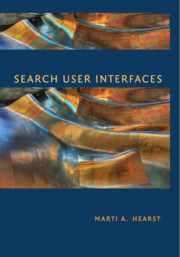Book contents
- Frontmatter
- Contents
- Preface
- 1 The Design of Search User Interfaces
- 2 The Evaluation of Search User Interfaces
- 3 Models of the Information Seeking Process
- 4 Query Specification
- 5 Presentation of Search Results
- 6 Query Reformulation
- 7 Supporting the Search Process
- 8 Integrating Navigation with Search
- 9 Personalization in Search
- 10 Information Visualization for Search Interfaces
- 11 Information Visualization for Text Analysis
- 12 Emerging Trends in Search Interfaces
- Appendix: Additional Copyright Notices
- Bibliography
- Index
- Author Index
- Plate section
8 - Integrating Navigation with Search
Published online by Cambridge University Press: 05 March 2013
- Frontmatter
- Contents
- Preface
- 1 The Design of Search User Interfaces
- 2 The Evaluation of Search User Interfaces
- 3 Models of the Information Seeking Process
- 4 Query Specification
- 5 Presentation of Search Results
- 6 Query Reformulation
- 7 Supporting the Search Process
- 8 Integrating Navigation with Search
- 9 Personalization in Search
- 10 Information Visualization for Search Interfaces
- 11 Information Visualization for Text Analysis
- 12 Emerging Trends in Search Interfaces
- Appendix: Additional Copyright Notices
- Bibliography
- Index
- Author Index
- Plate section
Summary
This chapter describes interfaces to support navigation (or browsing) as part of the search process. Chapter 3 discusses theoretical models of browsing versus search as information seeking strategies, as well as the notion of information scent and information architecture. As mentioned there, one way to distinguish searching versus browsing is to note that search queries tend to produce new, ad hoc collections of information that have not been gathered together before, whereas navigation/browsing refers to selecting links or categories that produce pre-defined groups of information items. Browsing activities can also include following a chain of links, switching from one view to another, in a sequence of scan and select operations. Browsing can also refer to the casual, mainly undirected exploration of navigation structures.
Navigation structures lend themselves more successfully to books, information collections, personal information, Web sites, and retrieval results than to vast collections such as the Web. Nonetheless, there have also been attempts to organize very large information collections such as the Web.
Category systems are the main tool for navigating information structures and organizing search results. A category system is a set of meaningful labels organized in such a way as to reflect the concepts relevant to a domain. A fixed category structure helps define the information space, organizing information into a familiar structure for those who know the field, and providing a novice with scaffolding to help begin to understand the domain. Category system structure in search interfaces is usually either flat, hierarchical, or faceted (this is discussed in detail below).
- Type
- Chapter
- Information
- Search User Interfaces , pp. 174 - 210Publisher: Cambridge University PressPrint publication year: 2009
- 1
- Cited by



